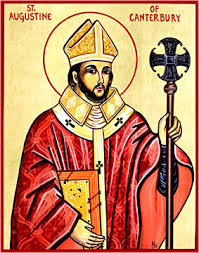Just as St. Patrick is often called the Apostle of Ireland, and St. Boniface is called the Apostle of Germany, today’s missionary hero – St. Augustine of Canterbury – is frequently called the Apostle of England. [Augustine of Canterbury should not be confused with the great African saint, Augustine of Hippo.]
When he grew up, Augustine became a Benedictine monk. In time, Fr. Augustine became the prior of the Benedictine monastery in Rome. On the orders of Pope Gregory the Great, Fr. Augustine and forty monks went from Rome to bring Christianity to the Anglo-Saxon people in what today is known as England.
When the missionary band arrived in Gaul (present-day France), they heard nightmarish tales of how ferocious the Anglo-Saxon people were and how dangerous it was to cross the English Channel. So, Augustine and his monks returned to Rome. Gregory, however, told them that the tales they had heard were groundless, and they should go back.
So, Augustine and his men went to a part of England called Kent, which was ruled by a pagan named Ethelbert who was married to a Christian woman. Ethelbert received the band of missionaries kindly, and soon they set up their headquarters in Canterbury. On Pentecost Sunday, 597, King Ethelbert was baptized with many others.
Soon afterwards, Augustine was consecrated a bishop in France and returned to Canterbury. There, he built a monastery and founded his see (diocese). Eventually, Bishop Augustine also founded other dioceses including that of London, and he appointed several bishops to serve various parts of England.
Unlike many Christian missionaries before him, Augustine incorporated many modern-day missionary principles that were not generally known in his time. In many ways, he modeled St. Paul, using the practices and rituals of the people and, instead of condemning them, incorporated these local customs into Christian worship.
St. Augustine of Canterbury died between 604 and 605 and is a patron saint of England. His feast day is May 27.



